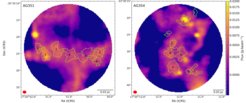High-mass star formation
High-mass stars (M > 8 Msun) play a key role in the energetic budget of the interstellar medium, especially during the last stages of their evolution, when they explode as supernovae. They are rare and short-lived, if compared to low-mass counterparts, and as a consequence on average they are found more distant from the Solar System. They form in dense and crowded environments, known as infrared dark clouds (IRDCs), heavily obscured by dust extinction. As a result, observational studies of the initial stages of high-mass star formation are challenging. In the CAS group, we exploit state-of-the-art interferometric facilities, such the Atacama Large Millimeter and sub-millimeter Array (ALMA), to characterize the physical properties of these regions. In particular, our research focuses on two main aspects:
Prestellar cores embedded in high-mass star forming regions.
The different theories developed to describe the high-mass star formation process make distinct predictions about the properties of the seeds of high mass stars, in particular regarding their masses. It is hence of crucial importance to provide reliable constraints on these properties from the observational point of view. In this context, in Redaelli et al. (2021) we have reported the first detection of o-H2D+ (11,0- 11,1) in the high-mass regime with ALMA. o-H2D+ is a light deuterated species not significantly affected by freeze-out onto the dust grains, and it therefore represents an ideal tracer of the prestellar gas. We have analysed two clumps, AG351 and AG354. The three-dimensional position-position-velocity datacube was analysed by means of dendrogram analysis, to identify the population of prestellar cores (see Fig. 1). Interestingly, the distribution of the o-H2D+ emission does not correspond to the morphology of the dust thermal emission at 0.8 mm, and from the linewidth of the spectra we derived gas temperatures lower than 10K. This suggests that several cores seen in o-H2D+ may not present bright continuum emission because a) they are in a very early evolutionary stage, and a clear over density peak has not formed yet or b) the 0.8 continuum observations are not able to trace it.
Currently, we are performing the same analysis on a third clump, AG14, which is about 30 times more massive than the previous two (M~5000 Msun). This is a dense and dynamically active environment, where several outflows have been identified with ALMA observations of the CO (2-1) line (Sanhueza et al. 2019, Li et al. 2020). The dendrogram analysis reveals a population of 22 cores, with masses (computed at 10 K) of 1-30 Msun. Performing a viral analysis, we found out that most of the cores are subvirial (𝛼vir<1.0), which means that the gravitational pull cannot be balanced by thermal motions alone, and that the cores are prone to gravitational collapse, if no other source of pressure (such as magnetic fields) is present.

The gas kinematics at clump scales
High-mass star-forming regions are crowded and highly dynamically active environments. In this context, molecular lines are essentials to disentangle their complex structure. For instance, we have used N2H+ (1-0) ALMA data at a resolution of ~8000 au to investigate the kinematics of the clump AG14, with particular attention to the core-to-clump transition. The spectral line profiles of this transition are complex, with three distinct velocity components over almost the whole field-of-view. Interestingly, we found a correspondence between the N2H+ and H2D+ data: every structure seen in H2D+ corresponds to a single velocity component of the N2H+ line. The latter presents broader lines than the former. We can therefore kinematically link each quiescent core identified in the o-H2D+ data with the clump-scale gas component from which it formed.
We have fitted the N2H+ data with a multi-component Gaussian fit. The results of this procedure have then been given as input to the hierarchical clustering algorithm acorns (Henshaw et al. 2019). This algorithm performs a friend-of-friend kind of analysis on already decomposed (i.e. fitted) data, clustering data based on their proximity in four dimensions (position-position-velocity-velocity dispersion), and looking for their hierarchical structure. The code identifies a total of 19 “trees”, five of which contain more than 80% of all data-points and 60% of the total flux. These five main clusters (See Fig. 2) are all associated with prestellar and/or protostellar cores, suggesting that they are all active in star-formation. One of these structures, in particular, presents a filament-like structure that appears to be accreting mass towards one of the protostellar cores identified in outflow emission. We estimate a mass accretion rate towards the protostar of Ṁacc ~ 2x10-4 Msun yr-1, in agreement with other observational and numerical results.
References
Colombo, D., Rosolowsky, E., Ginsburg, A., et al., 2015, MNRAS, 454, 2067
Henshaw, J. D., Ginsburg, A., Haworth, T. J., et al. 2019, MNRAS, 485, 2457
Li, S., Sanhueza, P., Zhang, Q., et al. 2020, ApJ, 903, 119
Redaelli, E., Bovino, S., Giannetti, A., et al. 2021, A&A, 650, A202
Sanhueza, P., Contreras, Y., Wu, B., et al. 2019, ApJ, 886, 102
